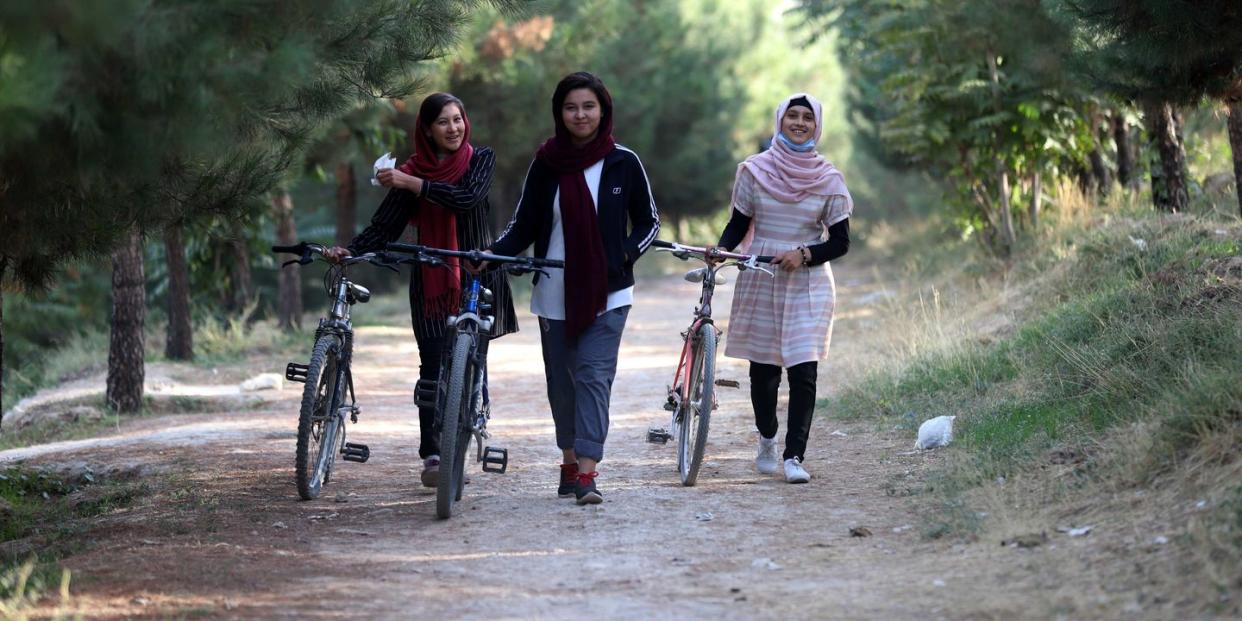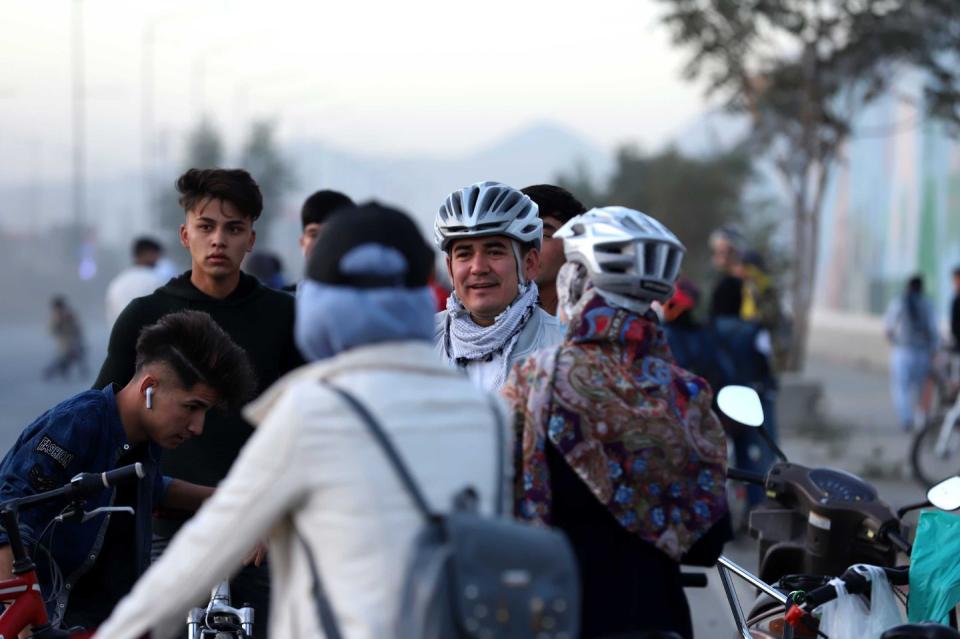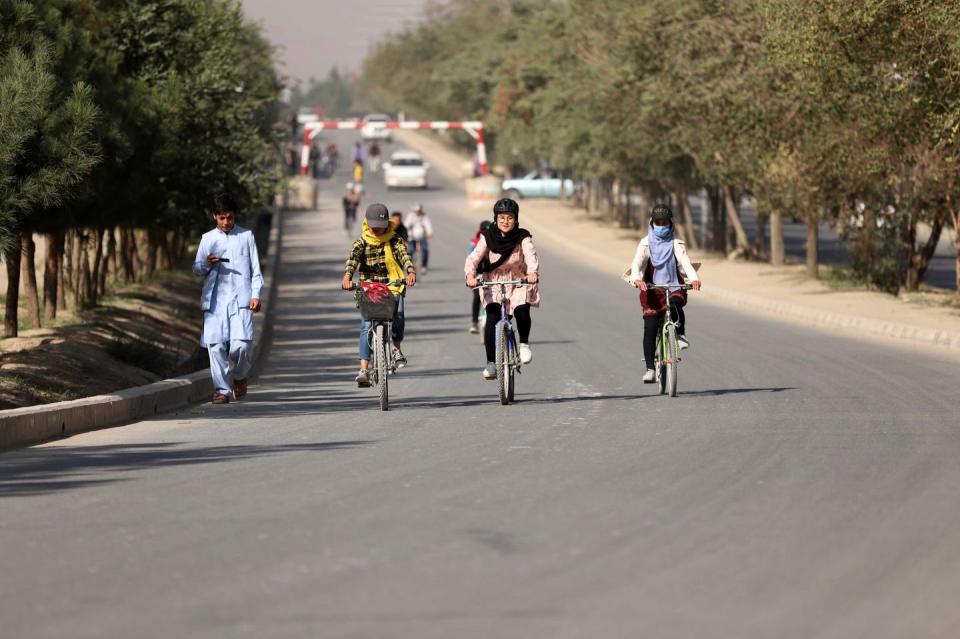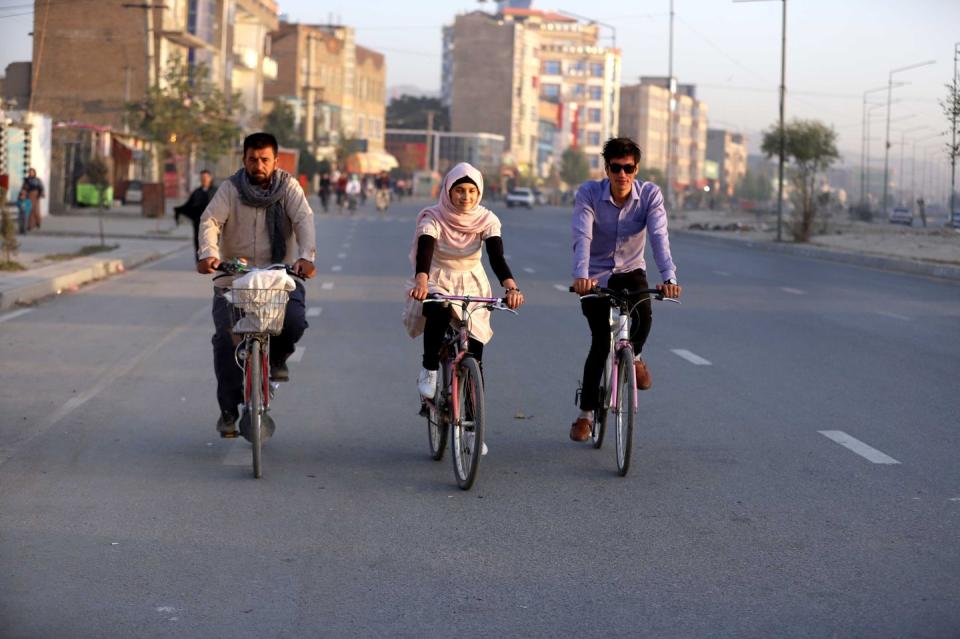These Afghan Women Are Defying the Patriarchy — on Bikes

Around the world, the coronavirus pandemic has given the bicycle new popularity as both a desirable form of transportation and a cure for boredom. In Afghanistan, that shift is kindling a quiet revolution, opening a small window for long-overdue social change: A large mixed-gender group has formed to ride the streets in Kabul, carrying hopes for lasting impact.
Twice a week at 5 a.m., Hamidullah (Hamid) Rafi, 27, leaves his home in an overcrowded neighborhood in western Kabul on his bicycle, a Chinese knockoff reminiscent of the early coil shock mountain bike prototypes. He purchased it brand-new from a bike shop during the pandemic. Accompanying him, on bikes also recently acquired from the same shop, are his wife, Sahiba Alizada, 24, and his younger brother, Azizullah, 21. Sahiba, her hair tightly wrapped in a cashmere scarf, wears black jeans under a belted shirt that extends past her knees; Azizullah carries food and first aid supplies in a backpack.

Their first stop, where more riders join, is a nearby four-story shopping center of a type typically found in Kabul, where you can buy anything from kitchenware to clothing. While the rest of the city sleeps, they pedal in pairs on empty roads normally packed with cars and pushcarts. By the time they arrive at Qargha Lake, a weekend getaway about 15 kilometers west of the city, the group comprises about 60 riders, more than half of whom are women. Single-speed cruisers dominate the lineup; most are borrowed from a cousin or an uncle. No one is wearing a helmet, and despite the early morning darkness, the bicycles aren’t equipped with safety lights. In Qargha, some members dip their toes into the lake and splash water on one another, while others spread a picnic sofra (tablecloth), layering it with naan, cream, and dates. Is this an air of normalcy in a place where that word has escaped both memory and imagination? Perhaps.
The group coalesced during Kabul’s coronavirus lockdown when, like many metropolitan areas around the world, the city was experiencing exceptionally good air quality from the lack of motor traffic. One day in May, Hamid noticed something peculiar, unprecedented even: For the first time, he could see the distant peaks of the Shir Darwaza Mountains in the northeast. They’d been obscured under what had become a permanent feature of Kabul’s climate: a thick mix of smog and dust. The city’s population has surged past four million in recent years, and Kabul’s air is now among the worst in the world. The problem is so dire that residents on social media have declared it a “bigger threat than terrorism.”
Motivated by the sight of a clean Kabul, Hamid decided he no longer wanted to play a role in polluting it. So he bought a bike.
This wasn’t Hamid’s first bike. Fourteen years ago he migrated to Kabul from a remote village in central Afghanistan, where he worked on his family farm and walked an hour and half each way to school. In Kabul he continued to walk everywhere, often showing up late to school after helping his father in their small brickmaking factory. One day, his father surprised him with a single-speed bicycle equipped with a dynamo-powered headlight. Hamid added his own accessories: a loud “police siren” bell, and a bouquet of plastic roses on the handlebar to “impress girls.”

Hamid’s bicycle became a catalyst for new personal and professional opportunities. Motivated to find his own place in a rapidly growing Kabul, he used the time saved from commuting to enroll in English classes where he became fluent; he now earns a living as a translator. But when he started his undergraduate studies at Kabul University, where business attire is the norm, the bike had to go. “Fake pride,” he says. “People in Kabul view riding as lowly when you are in a suit and tie.”
Though Hamid’s return to cycling began in good conscience for the environment, it soon morphed into something unexpected. After he posted a short Facebook clip of that first ride with Sahiba and Azizullah, requests to join began coming in, mostly from women who were encouraged by Hamid’s wife. “I saw a friend’s Facebook story that she had gone out to cycle,” says 18-year-old student Habiba Halimi, who showed up for her first ride on her 10-year-old sister’s bike.
Hamid’s informal jaunt to the lake had sparked a departure from tradition in Kabul’s male-dominated society, where under the Taliban regime, girls were prohibited from attending school and women could be punished for leaving the house alone. In the last two decades under the Islamic Republic of Afghanistan—backed by the United States and the international community—women have gained more freedom and equality. Millions of girls have gone to school, and a significant number of them are now joining the workforce in both the private and public sectors, with some holding key leadership roles in the government.

But despite a constitution that grants equals rights for women, Afghanistan’s conservative society has been slow to embrace change. Some traditionalists still consider women’s independence as a moral corruption of the society. Women riding bicycles are sometimes viewed as committing one of the gravest violations of a culture that sees their place only inside the house—a judgment that can significantly affect a young woman’s future prospects, from marriage to work. Perhaps it is the bicycle’s liberating nature that makes it so contested: It is at once a catalyst for change and a threat to society’s long-held patriarchal traditions.
Hamid and I attended the same high school in Kabul in the late 2000s. During morning assemblies, he’d often kick off the day by reciting the Quran through a bullhorn in a lyrical tenor voice in front of 500 students lined up on a dusty soccer field. His nickname was Qari, referring to someone who knows the Quran by heart. He asked me recently, “Tell me, what part of women riding a bicycle is un-Islamic? If you see a girl on a bike who is dressed within our religious and cultural boundaries, what sin is she committing?”
Jada-e Shahid Mazari is a long, straight stretch of road that connects a significant portion of western Kabul to the rest of the city. Named after a leader of the mujahideen (religious holy warriors who resisted the 1980s Soviet occupation) who was killed by the Taliban in 2000, it is just wide enough for two vehicles. It has no lanes or shoulder. Mornings are quiet, but by afternoon it is common for four lanes of traffic to form, squeezing cyclists in the cracks between the slow-moving cars. This is the main road Hamid’s group follows out of the city and back.
Habiba’s first ride with the group was in early June. She and her older brother, Hashim, 19, carefully snuck out the door so their mother wouldn’t see; Habiba was on her little sister’s bike, her brother on a neighbor’s cruiser.
They waited at the group’s predetermined meeting spot, which Hamid had announced in a secret Facebook group chat. More girls showed up, riding the narrow and unpaved streets, accompanied for safety by male members of the group who had been assigned by Hamid a day before the ride.

The group set out on Jada-e Shahid Mazari. As they pedaled the empty roads, more riders joined from locations along the route: At a roundabout with a large marble statue of Mazari. On a flyover bridge, Kabul’s first, erected to unlock traffic jams primarily caused by pushcarts. At a spot where the Kabul-Kandahar highway also stretches westward, each passing mile increasing the risk of roadside abductions and killings until it becomes entirely Taliban territory. At Kabul Polytechnic University, its Soviet-era block buildings intact after almost half a century of conflicts.
From Polytechnic they took a left turn on Qargha Road, which extends west with a gradual incline toward the Paghman Mountains, whose snow-capped peaks levitate above Kabul’s thick smog. The final steep kilometer before Qargha Lake proved challenging for Habiba on her single-speed kids’ bike but she soldiered on, motivated by the big body of blue water within reach.

On the way down, her scarf flapped against the wind, and as the screechy bike picked up speed, she smiled. “I had never felt freer,” she said later. But with more people and cars on the streets, the ride back from Qargha was not as peaceful. There were demeaning comments from drivers, risks of encountering bandits keen on stealing the bikes, and men lurking who taunted the women.
So far, the group’s large size has kept harm at bay, but the dangers are real. Recently, Habiba saw on Facebook that a private guard at a university had pushed a female cyclist to the ground on Qargha Road. Her head hit the sidewalk and later had to be repaired with five stitches. “When we find people suspicious of causing trouble, we surround them in a wide circle and make loud noises,” Hamid says. “Usually they leave.”
The pace of public opinion lags behind the brisk expansion of the cycling group. Before the pandemic, with the exception of a few members of the national cycling team, almost no women could be seen on bikes in Kabul. Hamid’s group is one of the first to organize rides there, drawing dozens of women out on bikes, which makes the group’s presence both an unparalleled opportunity and a challenge. On one hand, the ice is already broken. On the other, people who take issue with women on bikes are determined to put a stop to it. Recently, a mullah denounced the progress in a sermon and on Facebook, saying that “riding bicycles, some girls have turned western Kabul into the West. We will make it their prison.” In a society that continues to top the list of worst places to be a woman by organizations like Amnesty International, that kind of statement from a religious leader is a legitimate threat.
“I am genuinely afraid of someone opening fire on us while we are cycling,” says Farishta Afzaly, 25, who is now pursuing her master’s degree in educational policies for global development. And that fear has roots in recent tragic history. In 2018, an Islamic State suicide bomber detonated himself inside a crowded mixed-gender classroom, killing more than 40 students, including Hamid’s 17-year-old sister, Rahila. That day, Hamid searched for Rahila’s body among piles of corpses in several hospitals, eventually recognizing her from her wristwatch. When relatives put together a fund to cover funeral expenses, Hamid announced that the money would be used instead to build a library in Rahila’s name. In her diary, Rahila had written: “This society will overcome its current crisis by solutions drawn from the knowledge and education of its youth.” Later in an interview, Hamid said: “My sister died trying to realize her dream to make our society a better place. This library will keep that dream alive.” Today, the Rahila Foundation is a thriving educational organization that also offers scholarships and professional development workshops to hundreds of ambitious girls and boys.
If sitting in a classroom is a sin for girls, then sitting on a bike is sinning at another level, bringing the idea of women’s independence into the open—and inviting a greater risk of retaliation. But for Hamid and his team, if the moment for change is not now, then when is it? “We have already done what was unimaginable just over three months ago. In the minds of many, we have broken the myth that girls cannot ride,” says Habiba. “We can only grow what we have started.”


The bike has proved crucial for Habiba, who is currently trying to earn a university scholarship abroad. To prepare, she must go to an educational center on the other end of Kabul where she can access textbooks for English and other subjects. “My family can’t afford the transportation costs to send me there every day,” she says. On a bike it costs nothing.
Farishta, who learned to ride while studying abroad in Bangladesh and South Korea, believes the bicycle can be useful for other social causes as well. In Bangladesh, she participated in a 220-kilometer bike rally to promote a cleaner environment. She hopes Hamid’s Kabul group can organize similar programs locally.
For now, Hamid thinks they must focus on two goals: getting more women to ride and raising awareness about cycling etiquette and safety. “Every ride is an opportunity for achieving those goals,” he says. Acquiring helmets, which are hard to find in Kabul, is also a priority. The group’s main concern is to bring gradual change without compromising safety. That means imposing limits on adding new members while pushing boundaries in other areas, like riding in busy hours and locations.
“To change this culture, we must show the image of a girl on a bike to as many people as possible,” Farishta says. “It’s like driving: A few years ago, [it was frowned upon for] women, but now it’s normal. We can do the same with cycling.”
Editor’s Note: Farid Noori is an elite mountain bike racer and the founder of the nonprofit Mountain Bike Afghanistan. The organization recently sent 25 helmets (donated by Specialized Bicycles) to Hamid’s group.
A previous version of this article suggested that Hamid's group was the first of its kind in Kabul. There has been at least one other.
You Might Also Like

